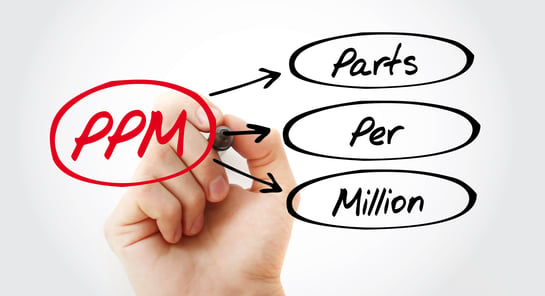"Percent," "parts per million (ppm)," and "parts per billion (ppb)" are terms used in industry and in calibration to describe accuracy or uncertainty specifications in measurement instruments and calibrators.

Instruments used for precise measurements all have uncertainty associated with the measurements they provide. After all of the known or suspected uncertainties have been recognized, evaluated, and corrections have been applied, there still remains an uncertainty about the correctness of the result. Uncertainty quantifies the doubt about how well the result of the measurement represents the true value of the thing being measured (aka the "measurand"). According to the GUM (Guide to Uncertainty in Measurement), uncertainty "characterizes the dispersion of the values that could reasonably be attributed to the measurand."
The GUM also describes accuracy as the "closeness of the agreement between the result of a measurement and a true value of the measurand." Accuracy should be used as a qualitative term where there is no quantity assigned, such as "The accuracy of this calibrator is better than that one." However, in practice, many people use the term accuracy and uncertainty interchangeably.
Consumers of pressure and temperature measuring devices and calibration equipment need to know the accuracy of their instrument in order to know and report the specifications of the devices they are using or calibrating. Depending on the degree of accuracy that is being reported, percent, ppm or ppb can be used.
Percent (%) is used in every day conversation to describe the occurrence of an outcome based on a sample of 100, or a part of a whole expressed in hundredths. For example, if there are 200 questions on an exam and you get 170 correct you have 170/200=0.85 that is 85 out of 100 or 85%. In pressure calibration, a typical accuracy is +/-0.01% of the full scale range of a device (written as 0.01% FS). This means the measured value could be above the true value by 0.01% or below the value by 0.01%. The dispersion distribution of possible values for a measurement taken at 200 psi would be from 200-(200*0.01%) to 200+(200*0.01%) or from 199.98 to 200.02 psi.
We would call this a high accuracy pressure sensor, but there are more accurate sensors than this. Another way to refer to percentage is parts per hundred (pph). We can describe ppm and ppb like a percentage except that the value is expressed in relation to one million and one billion, respectively, or as parts per million and parts per billion.
As accuracy specifications increase, it becomes easier to express the uncertainty in ppm or ppb because there is no need for a bunch of zeros after a decimal point, as seen below in the equivalency between these terms:
0.01% = 100 ppm = 100,000 ppb
1 ppm = 0.0001%
1 ppb = 0.0000001%
In pressure calibration, the race to higher accuracy has necessitated the use of ppm, especially on the state-of-the-art pressure calibration equipment. Mensor's CPD8500 Digital Deadweight Tester has an accuracy of +/- 35 ppm, and the equivalent percentage is 0.0035%. In temperature calibration, accuracy can be much higher. For WIKA's Primary Standard Resistance Thermometry Bridge the accuracy is +/- 20 ppb.
Related Reading:



